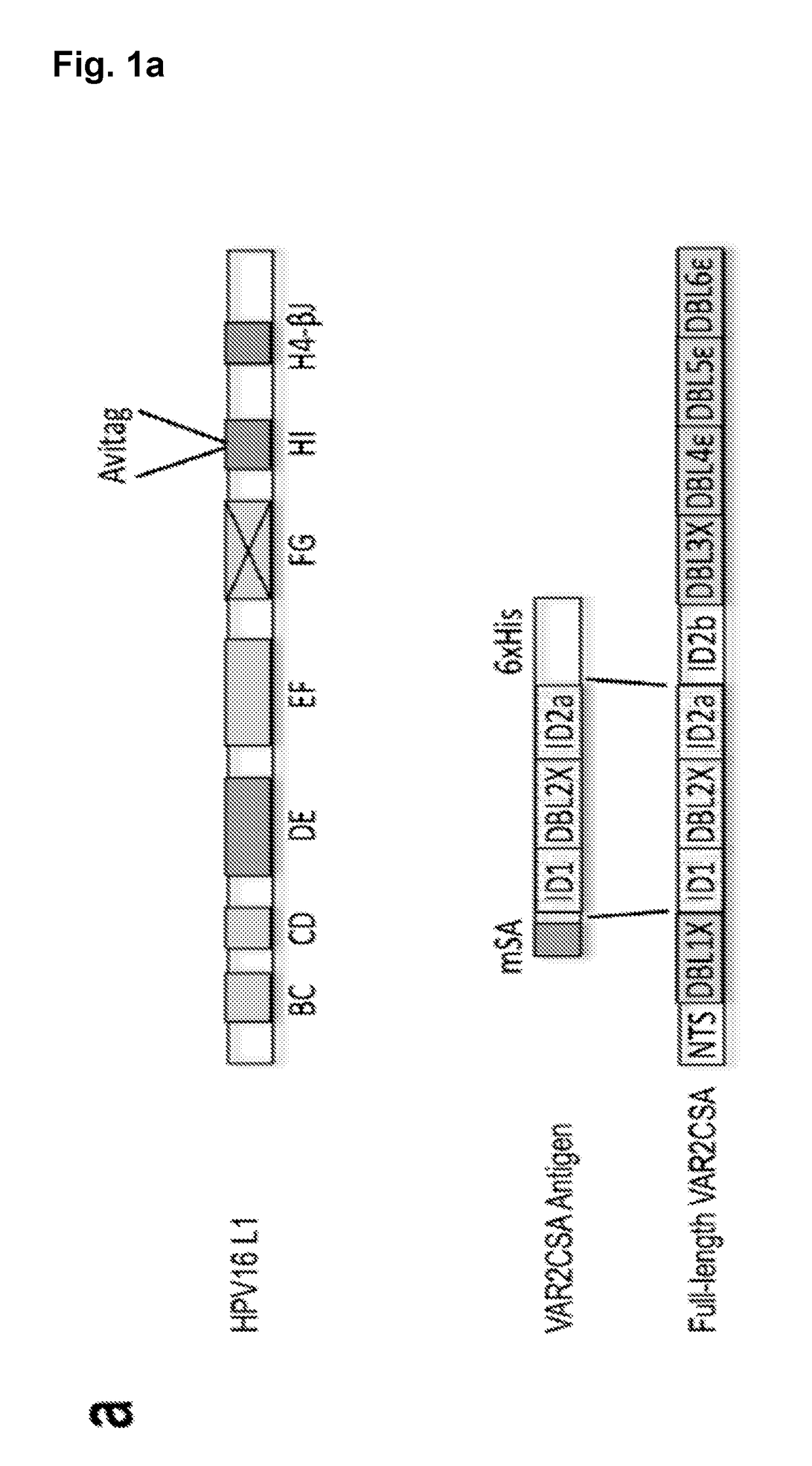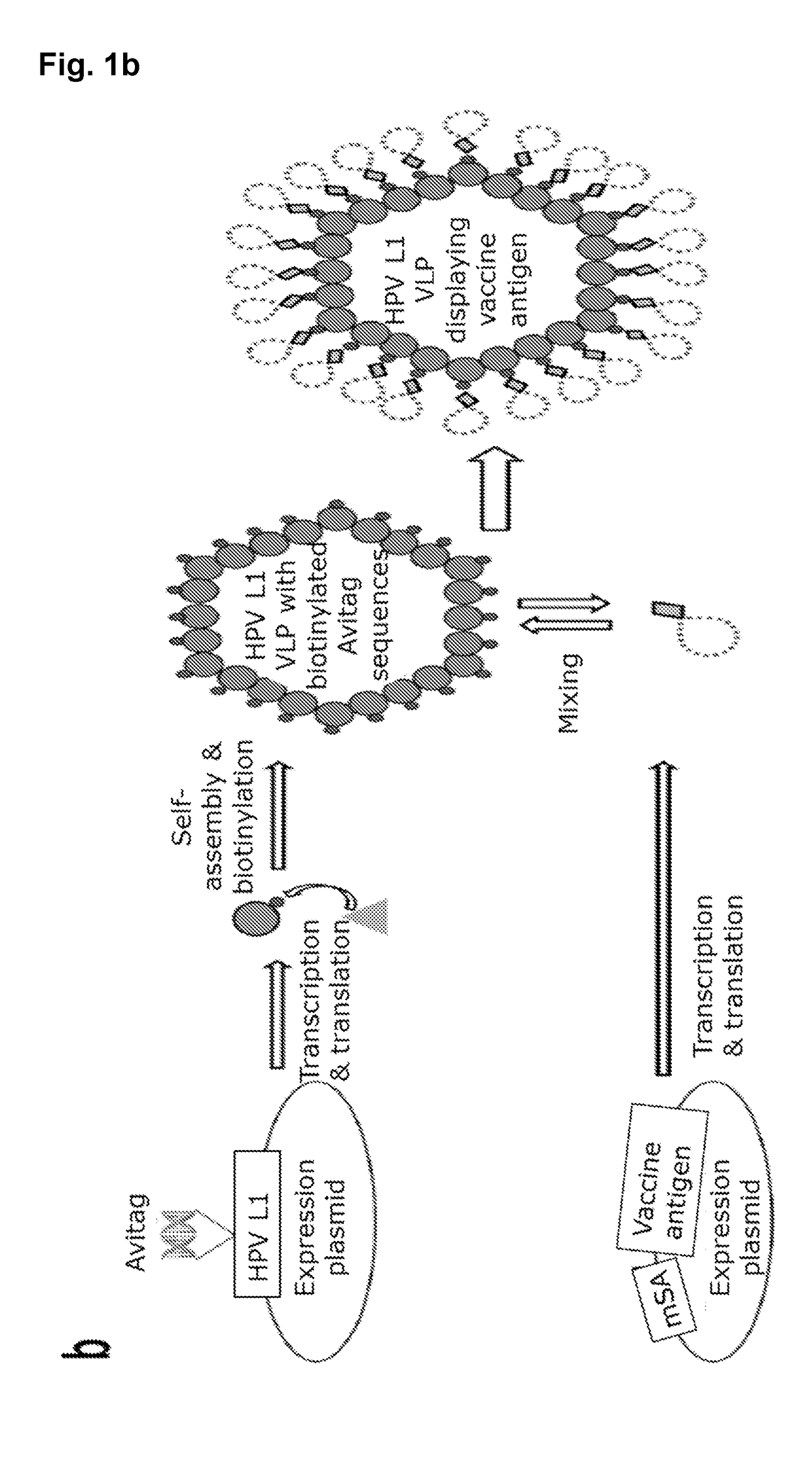Virus like particle with efficient epitope display
- Summary
- Abstract
- Description
- Claims
- Application Information
AI Technical Summary
Benefits of technology
Problems solved by technology
Method used
Image
Examples
example 1
Design of Chimeric HPV16 Avi-L1 Coat Proteins
[0318]The chimeric HPV16 Avi-L1 gene sequences were constructed by insertion of the biotin acceptor sequence (AviTag™), GLNDIFEAQKIEWHE, into the DE- (aa positions 134-139), FG- (aa positions 279-286), HI- (aa positions 351-352) or H4-βJ coil (aa positions 431-432) after having deleted any intervening amino acids (HPV16 L1 accession number DQ155283.1). Gene sequences were further modified to contain an EcoRV restriction site followed by a polyhedrin promotor sequence at the N-terminus and a stop-codon followed by a NotI restriction site at the C-terminus. The synthetic gene sequences were finally codon-optimized for recombinant expression in Trichoplusia ni cells and synthesized by Geneart (Life Technologies).
example 2
Expression and Purification of Chimeric HPV16 Avi-L1-VLPs
[0319]The HPV16 Avi-L1 gene fragments were cloned into the EcoRV / NotI sites of the pAcGP67A vector (BD Biosciences) deleting the gp67 secretion signal sequence. To generate recombinant virus particles, linearized BakPak viral DNA (BD Biosciences) was co-transfected with pAcGP67A / Avi-L1 into Sf9 insect cells using Lipofectamine 2000 10 Reagent (Invitrogen, 11668-019) and incubated at 28° C. for 3-5 days. Recombinant Baculovirus was harvested from the supernatant and used to generate a high-titer virus stock, which was used for infection of High-Five insect cells. Infected High-Five cells were incubated for 48 hours at 28° C. with shaking. In vitro maturation and purification of HPV16 Avi-L1 VLPs were performed as previously described (Buck et al., 2005, Buck et al., 2007). In brief, cell lysates were harvested and VLPs were allowed to mature in maturation-buffer (0.5% Triton-X-100, 0.1% Benzonase® Nuclease (Sigma-Aldrich), 25 m...
example 3
Gene Design and Recombinant Expression of Biotin-Binding Vaccine Antigens
[0320]Heterologous vaccine antigens were genetically fused with a GGS linker at either their C- or N-terminus to a previously described (refs) / patented (U.S. Pat. No. 8,586,708 B2) engineered monovalent streptavidin (mSA) (SEQ ID NO: 37), thereby introducing biotin binding capability to the expressed mSA-antigen fusion proteins. mSA-antigen fusion genes expressed in E. coli were designed with a 6×Histidine tag and NcoI / BamHI restriction sites for subcloning into pET-15b vector. mSA-antigen fusion genes expressed in either S2 cells, Human Embryonic Kidney 293 (HEK293) cells or in Baculovirus infected insect cells were designed with flanking EcoRI / BamHI (N-terminal) and NotI (C-terminal) sites and a 6×Histidine tag and were subcloned into the pHP34s, pcDNA™4 / HisMax or pAcGP67A (BD Biosciences) vector, respectively.
PUM
| Property | Measurement | Unit |
|---|---|---|
| Fraction | aaaaa | aaaaa |
| Time | aaaaa | aaaaa |
| Time | aaaaa | aaaaa |
Abstract
Description
Claims
Application Information
 Login to View More
Login to View More - R&D
- Intellectual Property
- Life Sciences
- Materials
- Tech Scout
- Unparalleled Data Quality
- Higher Quality Content
- 60% Fewer Hallucinations
Browse by: Latest US Patents, China's latest patents, Technical Efficacy Thesaurus, Application Domain, Technology Topic, Popular Technical Reports.
© 2025 PatSnap. All rights reserved.Legal|Privacy policy|Modern Slavery Act Transparency Statement|Sitemap|About US| Contact US: help@patsnap.com



